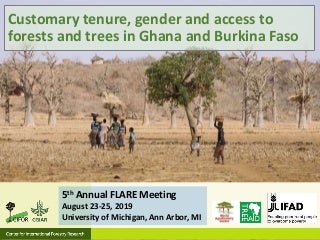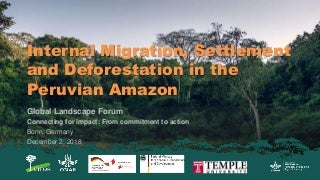Flagship 2: Livelihood systems
The area of livelihoods is the starting point for this research theme because smallholders make decisions about how to manage farms, considering all their constraints and opportunities, including those unrelated to trees and forests. In addition to direct contributions to diet and income from timber, coffee, cocoa, rubber, oil palm, fruits, nuts and other products, much of the contribution that trees make is through system intensification, involving interactions with other livelihood components. For example, on-farm tree fodder increases livestock productivity while reducing labor required for collection, freeing time for people to invest in other paths to intensification. Such knock-on effects of better tree management are important. They include trees restoring and maintaining soil health through fostering higher abundance and activity of beneficial soil organisms, as well as contributing to soil fertility through tightening nutrient and water cycles, improving nutrient and water use efficiency and thereby closing yield gaps of food crops.
Latest news
Explore our resourcesOverview
Livelihood systems
Trees are productive, act as capital and provide other ecosystem services. They make livelihoods more sustainable when integrated in agricultural production systems. FTA’s research seeks to alleviate the constraints that people face in benefiting from tree and forest resources, even on their own land.
These include agronomic constraints, the time lag between investment in establishing trees and returns, regulated or underdeveloped markets for tree products, and policies that restrict what people can do with trees, because of forest legislation affecting land and tree tenure and usufruct rights. This is why this research theme addresses the enabling environment in tandem with technology development.
FTA’s research on livelihood systems focuses on how to:
| • | Manage trees in fields, farms and agricultural landscapes to meet livelihood needs, including deploying appropriate germplasm and managing it to deliver desirable outcomes, which includes developing options that use trees to improve and sustain soil health, restore land and avoid further degradation; |
| • | Develop markets for agroforestry products so that smallholders capture more value from what they produce; |
| • | Formulate policies that enable people to benefit from managing tree cover on their farms and collectively in forests; and |
| • | Bridge the time between investment in trees, and returns from them, using novel public and private financing options. |
| This research theme’s theory of change rests on three interrelated assumptions that: | |
| • | The current management of tree cover on farms, in pastures and at forest margins can be improved, contributing to sustainable intensification of livelihoods through higher total factor productivity, leading to higher food and nutrition security; |
| • | Smallholders and particularly women can achieve higher returns from tree and forest products by better marketing and processing, thereby increasing their income; |
| • | People (especially women, young people and other marginalized groups) can participate more in, and benefit more from, using tree and forest resources if policies, legislation and institutions affecting their use are reformed to enable this, including financing investment to establish trees. |
Through embedding some of its research within the scaling-up process, this research theme simultaneously accelerates impact for development partners while enabling research to be conducted at the scale at which FTA aspires to make impact.
This research theme’s partnership strategy involves three main types: donors, upstream research providers, and the users of FTA’s research outputs. Partnerships with the private sector cut across these as they may involve funding, collaboration in cutting-edge science and the use of research outputs. By engaging with development partners, the private sector and policymakers from the outset, FTA ensures that its outputs address important issues in a form suitable for uptake and maximize the likelihood of generating outcomes and impact.
Upstream partners include: Simulistics on livelihood trajectory modelling; Australia’s Commonwealth Scientific and Industrial Research Organisation (CSIRO) on incorporating trees within its Agricultural Production Systems Simulator (APSIM) suite of globally calibrated crop models; Bangor University in the UK on genomics to understand the functional profiles of soil biota; as well as many other universities — the Swedish University of Agricultural Sciences (SLU); Cornell, Columbia, Colorado and Montana in the United States; Adelaide and Southern Cross in Australia; Jomo Kenyatta University of Agriculture and Technology (JKUAT) in Kenya; Makerere in Uganda; and Mekele, Hawassa and Wondo Genet in Ethiopia.
Private sector partners include Mars Inc. on cocoa in Côte d’Ivoire; Natura on oil palm diversification in Brazil; and small and medium enterprises that codevelop novel products (e.g. non-perishable forms of Docynia indica in Vietnam).
IFAD, the World Wildlife Fund (WWF), WorldVision, Vi-Agroforestry, One Acre Fund, CARE and SahelEco are examples of partners for delivery at scale, together with national and local governments (for example in Ethiopia, Peru and Vietnam).
Research

Systems analysis, synthesis and scaling
This research area seeks to answer the following questions:
How can key tipping points in adoption of forest and agroforestry innovations leading to transformation of livelihoods be determined for food security and poverty reduction outcomes? What tools and methods will most efficiently, effectively and equitably support the generation and selection of diverse and inclusive options that improve the use of trees and forests by smallholders and codevelopment of principles for matching options to the fine-scale variation in context? How do contextual factors (biophysical and socioeconomic) affect the suitability of different types of innovations? How can new scientific evidence be most effectively curated to support policy development and negotiation among stakeholders to manage the impacts of land-use change on ecosystem service provision?

Production and marketing of food, fuel, timber, and non-timber forest products (NTFPs)
This research area seeks to answer the following questions:
How can key tipping points in adoption of forest and agroforestry innovations leading to transformation of livelihoods be determined for food security and poverty reduction outcomes? What tools and methods will most efficiently, effectively and equitably support the generation and selection of diverse and inclusive options that improve the use of trees and forests by smallholders and codevelopment of principles for matching options to the fine-scale variation in context? How do contextual factors (biophysical and socioeconomic) affect the suitability of different types of innovations? How can new scientific evidence be most effectively curated to support policy development and negotiation among stakeholders to manage the impacts of land-use change on ecosystem service provision?

Tree-crop commodities (cocoa, coffee, tea, oil palm and rubber)
FTA posits that the incorporation and management of companion trees in cocoa and coffee production systems, alongside appropriate fertilizer and pest control, can increase and sustain productivity of existing stands and buffer against climate change; that rubber and oil palm production systems can be made more sustainable through intercropping; and that smallholders can derive higher income from product sales through improved certification schemes and by exploiting specialist market niches, which lead to the following key research questions.
How can smallholder tree-crop commodity production systems be sustainably managed in the face of climate change, price volatility, declining yield and soil fertility following forest conversion, coupled with constraints on opening new forest areas, and those imposed by the dynamics of migration? What is required in terms of an enabling environment to switch from unsustainable monocultures to more diverse and resilient production practices?

Trees on agricultural land supporting land restoration and sustainable intensification
This research area seeks to answer the following questions:
What are the optimum levels of tree density and diversity in different contexts required to increase total factor productivity of smallholder livelihood systems while conferring resilience at farm and landscape scales? How can the desired tree density and diversity be most effectively promoted, given a widespread history of removing trees from agricultural land, conflicts between grazing animals and tree regeneration and promoting a few, largely exotic tree species on farms and in woodlots, rather than more diverse options? What is the relationship between tree cover (density and diversity) and soil health and where are there tradeoffs and synergies between production goals and the provision of other ecosystem services? How can key tipping points for land degradation be recognized, and used to avoid further degradation and prioritize restoration?

Silvopastoral systems
This research theme’s overarching hypothesis is that the establishment and better management of tree cover on pastures can contribute simultaneously to higher livestock productivity, animal welfare and biodiversity conservation, as well as restoring degraded rangelands and avoiding future degradation. This leads to the following key research questions. What is the relationship between tree cover and pasture and animal productivity and welfare in silvopastoral systems? Where are there tradeoffs and synergies between production goals and the provision of other ecosystem services?











